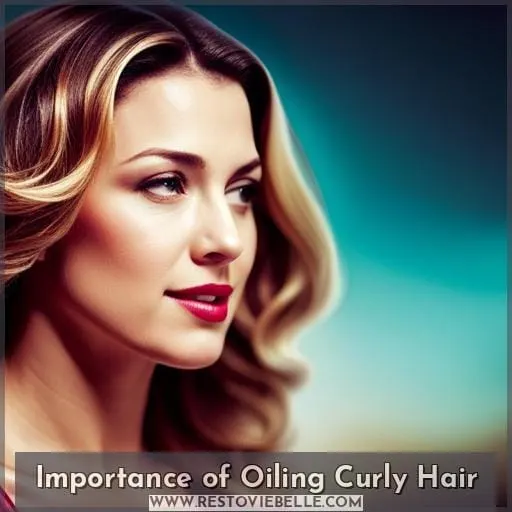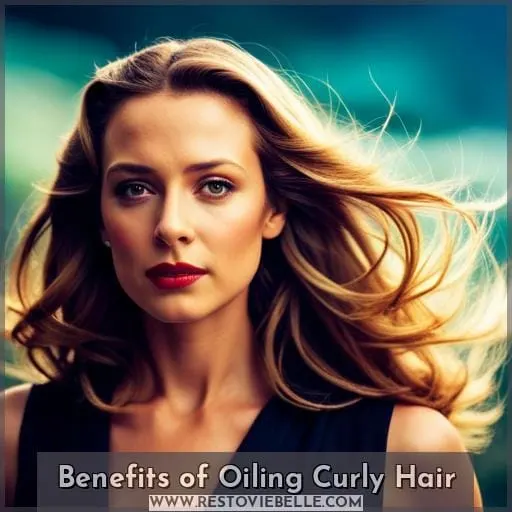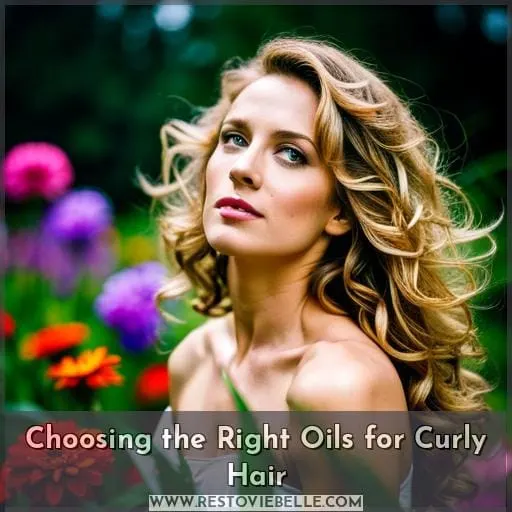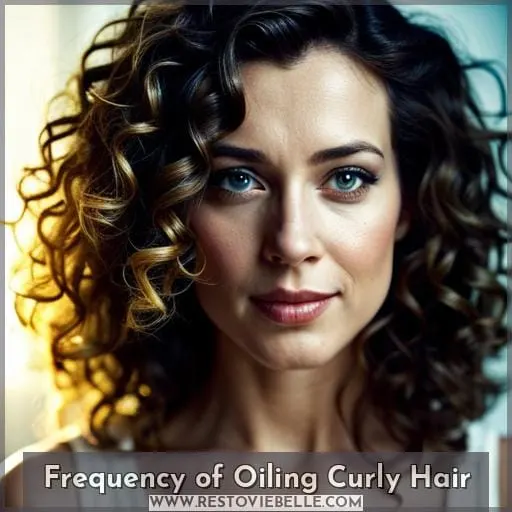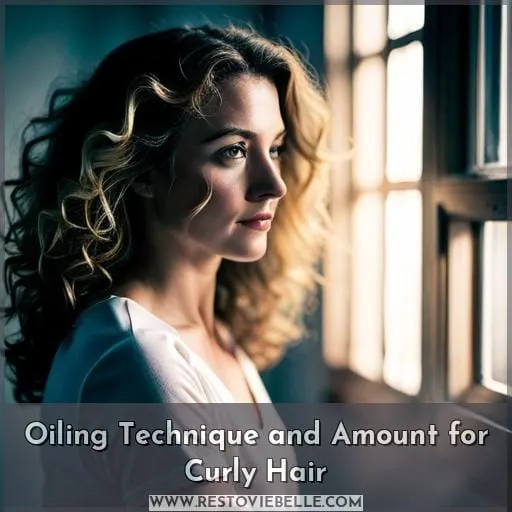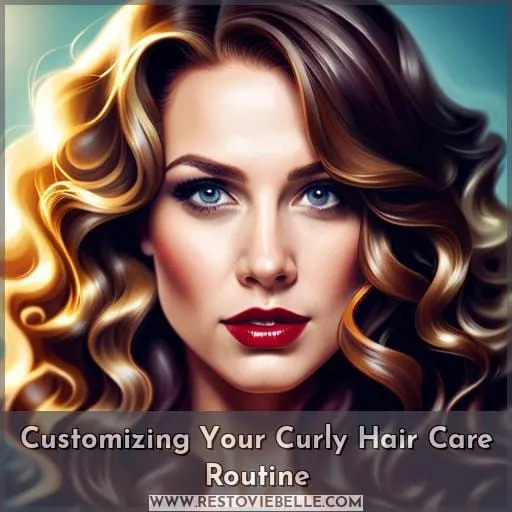This site is supported by our readers. We may earn a commission, at no cost to you, if you purchase through links.
 Are you struggling to keep your curls hydrated and frizz-free? You’re not alone! Oiling your hair is a great way to maintain moisture, but many of us don’t know how often you should oil curly hair.
Are you struggling to keep your curls hydrated and frizz-free? You’re not alone! Oiling your hair is a great way to maintain moisture, but many of us don’t know how often you should oil curly hair.
This article will help curl aficionados learn the basics of oiling their locks. From selecting the right oils for type 3 or 4 curls, to understanding when and how much product they need.
Understanding the importance of proper moisturizing techniques can be daunting at first glance. However, with some time and patience (and maybe even some trial-and-error), it’ll soon become second nature.
The key is knowing which oils work best on certain textures, as well as what frequency works best for your mane’s needs. Once a week could be too little or too much depending on individual factors such as weather conditions and lifestyle choices.
Table Of Contents
- Key Takeaways
- Importance of Oiling Curly Hair
- Benefits of Oiling Curly Hair
- Choosing the Right Oils for Curly Hair
- Frequency of Oiling Curly Hair
- Balancing Deep Conditioning and Oiling
- Oiling Technique and Amount for Curly Hair
- Customizing Your Curly Hair Care Routine
- Frequently Asked Questions (FAQs)
- Conclusion
Key Takeaways
- Curly hair types 3 and 4 require special attention for nourishment.
- Proper oiling helps restore moisture balance, texture, and shine.
- Adjust oiling based on weather and lifestyle; typically, weekly application is recommended.
- Listen to cues like dryness, itchiness, or flaking for personalized care.
Importance of Oiling Curly Hair
You need to incorporate oiling into your curly hair care routine for nourishing moisture and radiant shine. Different types of curls require different levels of attention, with type 3 and 4 needing the most moisturizing.
Oiling can restore balance to your scalp’s sebum production while providing protective hydration from within.
Select lightweight oils that match the texture of your hair – jojoba, argan, grapeseed for finer strands; castor, sunflower, almond, or coconut for thicker ones – then adjust frequency based on condition: weekly is generally recommended but listen to what works best with you!
Oil in small quantities before styling, then use a deep conditioner afterwards; too much can lead to greasiness, so be mindful when selecting the amount and technique used.
Personalize a suitable routine according to needs by finding appropriate products through experimenting – love those locks! Healthy curls are possible through consistent oiling coupled with good conditioning habits – let’s get started!
Benefits of Oiling Curly Hair
Oiling your curls is an essential part of hair care. Not only does it help retain moisture and improve texture, but it also provides nourishment for healthier hair.
Retaining Moisture
By regularly infusing your curls with the right oils, you can keep them hydrated and full of life.
- Select appropriate oil types based on hair needs (e.g., jojoba for fine type 3 curl strands; castor or coconut for thicker type 4).
- Use an oiling technique that involves massaging onto the scalp, then combing through to the ends with a wide-toothed comb.
- Seal in moisture by alternating between deep conditioning and lightweight oil applications each week, depending on the condition of the hair.
Improving Texture
Oiling is an essential part of curly hair care, as it helps to improve texture and ensure your luscious locks remain silky smooth. Moisturizing techniques such as oiling can be used in combination with a variety of styling tips for different curl types.
When selecting the right type of oil, consider its absorbency and weight. Coconut oil is often recommended due to its ability to draw moisture into strands. Oils like argan or jojoba are favorites for finer curls, while thicker type 4 hair benefits from castor or almond oils.
For best results, find the product that works best for you. Incorporating knowledge about curl types and favorite oils will help make sure your curls stay hydrated but not greasy!
Choosing the Right Oils for Curly Hair
Caring for curly hair requires the right kind of oils. Jojoba, Argan, and Grapeseed are ideal for finer type 3 curls, while Castor, Sunflower, Almond, and Coconut tend to work best on thicker type 4 hair.
Jojoba, Argan, and Grapeseed for Fine Hair
For fine, type 3 hair, nourish your curls with lightweight oils like jojoba, argan, and grapeseed for a glossy sheen. Oils should be applied in small amounts to the scalp and throughout the length of tresses.
Each oil has its own unique benefit; jojoba provides moisture while argan seals it in for long-lasting hydration, and grapeseed helps improve texture without weighing down strands.
Use these light oils to give your mane more shine than ever before! Experimenting with different types of oil is essential when it comes to customizing a routine that works best for you.
Castor, Sunflower, Almond, and Coconut for Thicker Hair
Castor, sunflower, almond, and coconut oils are great choices for thicker type 4 hair. Combining them in your routine gives you the nourishment and moisture needed to keep curls healthy.
For an optimal oiling technique, start by massaging the scalp with a few drops of oil before applying evenly throughout damp hair.
Remember to choose suitable oils based on absorbency levels and rotate between deep conditioners every other week for best results.
Frequency of Oiling Curly Hair
Caring for your curly hair requires more than just a wash-and-go routine; oiling is an important part of keeping curls healthy and hydrated. Typically, it’s recommended to oil once a week, but listening to your hair’s needs is the most important factor when deciding how often you should add oils to your regimen.
Oiling overnight can help boost moisture levels – start with a dry scalp, massage in some lightweight oil, and braid or cornrow before using a silk/satin bonnet for best results.
Typical Frequency (Once a Week)
Regularly treating your curls to a bit of oiling is key for happy, hydrated hair. The typical frequency of oiling curly hair is once a week, but you should adjust this based on your own needs and condition.
Determining the right amount and type of oils can be tricky. Choose according to scalp massage, texture, or type 4 hair if yours falls into that category. Make sure to select lightweight oils like jojoba or argan rather than heavy ones like coconut for best results! To get maximum benefits from overnight oiling, use an appropriate silk/satin bonnet with your preferred natural oils for curly hair like castor or almond before braiding it up tightly.
Listening to Hair’s Needs
Listen to your hair’s needs and adjust oiling frequency accordingly for hydrated, healthy curls. Pay attention to listening cues like scalp dryness, flaking, or itchiness. Different oils suit different hair textures, so choose the right one based on sebum imbalances and absorbency.
A small amount of lightweight oil should be applied before styling. Use a deep conditioner afterward if needed.
Cold water rinse after shampoo can help with oily scalps, while trimming split ends regularly helps prevent further damage from occurring.
Oiling Overnight Technique
Gently massage oil into your scalp before braiding and cover it with a silk or satin bonnet overnight for optimal results. This technique helps lock in moisture and allows the penetrative oils to deeply condition your hair while you sleep.
It is essential to apply an appropriate amount of oil – too much will make it greasy, while not enough won’t provide any benefits. To achieve the best results, customize your routine based on your hair type and texture.
Different oils are suited to different curl types. Incorporating deep conditioning alongside periodic oiling can also help keep your curls hydrated over time without weighing them down excessively. Ensure healthy curls all year round by creating a personalized schedule that works well with your lifestyle.
Experiment until you find the perfect balance between moisturizing and sealing your locks in place.
Balancing Deep Conditioning and Oiling
It’s important to understand how balancing deep conditioning and oiling your curly hair can make a big difference. When it comes to caring for your curls, rotating between these two treatments allows you to effectively seal in moisture while also restoring the health of your strands.
Sealing Vs. Restoring
You need to alternate between deep conditioning and oiling for the optimal look of your curls. Deep conditioners help seal in moisture and provide necessary nourishment, while oils restore shine, reduce frizz, and protect hair from environmental damage.
To balance these effects:
- Choose an appropriate oil based on your hair texture—fine or thick—and its absorbency rate.
- Use lightweight oils prior to styling; heavy oils after styling or overnight treatments with a silk/satin bonnet cap.
- Apply small amounts of oil evenly throughout the scalp before working down towards ends for maximum benefit without heaviness or greasiness.
By alternating sealing effects with restoring techniques, you can get healthy-looking curls that stay conditioned all day long!
Rotating Between Deep Conditioning and Oiling
Rotate between deep conditioning and oiling your curls every other week to keep them healthy, bouncy, and vibrant – like a spring breeze. Start by selecting the right oils for your hair texture; jojoba for fine type 3s while castor works best on thick type 4s.
Massage in lightweight oil before styling and use deeper conditioners afterward to lock in hydration.
Oiling Technique and Amount for Curly Hair
When it comes to caring for curly hair, the technique and amount of oil applied are key. It’s important to start with a small amount of lightweight oil before styling in order to prevent over-oiling, which can lead to greasiness or heaviness.
Starting With a Small Amount of Oil
Beginning with a small amount of oil helps determine the right quantity for your curls. It’s important to match the correct oil to your hair texture, massage it onto a dry scalp, and brush gently from root to tip.
Use a silk or satin bonnet when overnighting an oil treatment for maximum absorption within fragile curly hair strands. Oiling is essential in any routine tailored towards healthy curls. Consider frequency and amounts based on individual hair texture as well as conditioner use.
With proper care, understand that each head of curls will have its own unique needs.
Applying Lightweight Oil Before Styling
Applying a lightweight oil before styling your curls will give them the nourishment they need and keep them looking their best – after all, an ounce of prevention is worth a pound of cure!
Consider your conditioning method when selecting an appropriate oil type. A scalp massage with the right amount of oil should be done to gauge dryness in order to ensure proper hydration and nourishment for maximum shine.
When alternating between deep conditioning and regular oiling, use lighter oils for fine hair types while heavier ones are better suited for thicker locks.
For optimal results, select specific products according to curly hair tips that fit your individual needs! Avoid over-oiling as it can lead to unwanted greasiness; instead, find the perfect balance between hydrating treatments such as deep conditioners with sealing methods like oiling or creaming – this way you’ll make sure that every strand gets what it deserves without any excesses.
Avoiding Over-Oiling
To maintain healthy, hydrated curls, be careful not to overdo it when applying oils – too much can lead to greasiness and weigh down your hair. Avoid buildup by using protective styles or trial-and-error with essential oils and conditioner sealing.
Dry bristle brushes help distribute natural oils, while shampooing curly hair should include a pre-shampoo treatment for the best results.
Customizing Your Curly Hair Care Routine
Customizing your curly hair care routine is essential for achieving healthy, hydrated curls. Finding the right oils that suit your texture and applying them consistently with deep conditioning will help keep locks nourished and glossy.
Make sure to listen to your hair’s needs when deciding how often you should oil it – whether weekly or otherwise – in order to ensure maximum benefit from this vital step of any curl care regime.
Personalizing With the Right Oils
Choose the perfect oils for your curls to achieve maximum hydration and shine. Different oils have different weights, benefits, and suitability for hair dryness. Jojoba, argan, or grapeseed are lightweight and great for finer type 3 hair. Castor, sunflower, almond, or coconut work best on thicker type 4 locks.
Don’t forget that oiling from ends to roots helps gauge dryness effectively! Experiment with various curly hair oils to find the ideal amount – not too much as this will cause greasiness – while managing frizz and avoiding daily washing through gentle care techniques like using a bristle brush to distribute natural scalp oil.
Consistency With Oiling and Deep Conditioning
Consistently alternating between oiling and deep conditioning your mane will help keep it lusciously hydrated. For moisture retention, choose the right oils based on hair texture, and for scalp massage, use a lightweight version of the selected oil.
Adjust the amount of oil depending on scalp issues such as clogged pores or dryness to maintain curls without over-oiling, which can cause heaviness or greasiness.
Establish an effective routine that works best for you. How often should you oil curly hair? What type of oils are most suitable? Find out through experimentations tailored to your needs! An optimal combination with proper technique is key in helping restore nourishment while protecting from breakage due to friction and environmental damage.
Frequently Asked Questions (FAQs)
What is the best way to prepare my hair for oiling?
Have you ever wondered what the best way is to prepare your hair for oiling? Start with a dry scalp and massage in a lightweight oil, then braid it up before bed and cover it with a silk or satin bonnet.
Can I use oil to style my curls?
Yes, you can use oil to style your curls! For optimal results, opt for lightweight oils such as jojoba or argan and apply them from the ends to the roots.
Is it better to oil before or after showering?
Oiling your curls before or after showering? It’s totally up to you! Whether it’s pre-shower nourishment or post-rinse replenishment, the choice is yours. Satirize that ‘do with an oil your hair will love and let its unique texture shine through.
Can I use the same oil for my scalp and ends?
You can use the same oil for your scalp and ends, but make sure to adjust the amount accordingly.
How can I tell if I am over-oiling my hair?
You can tell if you are over-oiling your hair by paying attention to its texture. If it feels heavy or greasy, try using a lighter oil or reducing the amount of oil used – experiment and find what works best for your curls! Visualize healthy, hydrated locks as you nourish them with the right oils and care.
Conclusion
It’s no secret that caring for curly hair can be a challenge. But with the right combination of oils, deep conditioning, and frequency, you can maintain healthy, frizz-free curls. Oiling your hair once a week is a great way to keep it nourished and hydrated. Choose lightweight oils like jojoba, argan, and grapeseed for fine hair, and castor, sunflower, almond, and coconut for thicker hair.
When applying oil, start with a small amount and work your way up, and use a deep conditioner after styling. Finally, customize your own routine with the right oils, care, and love for the best results.
